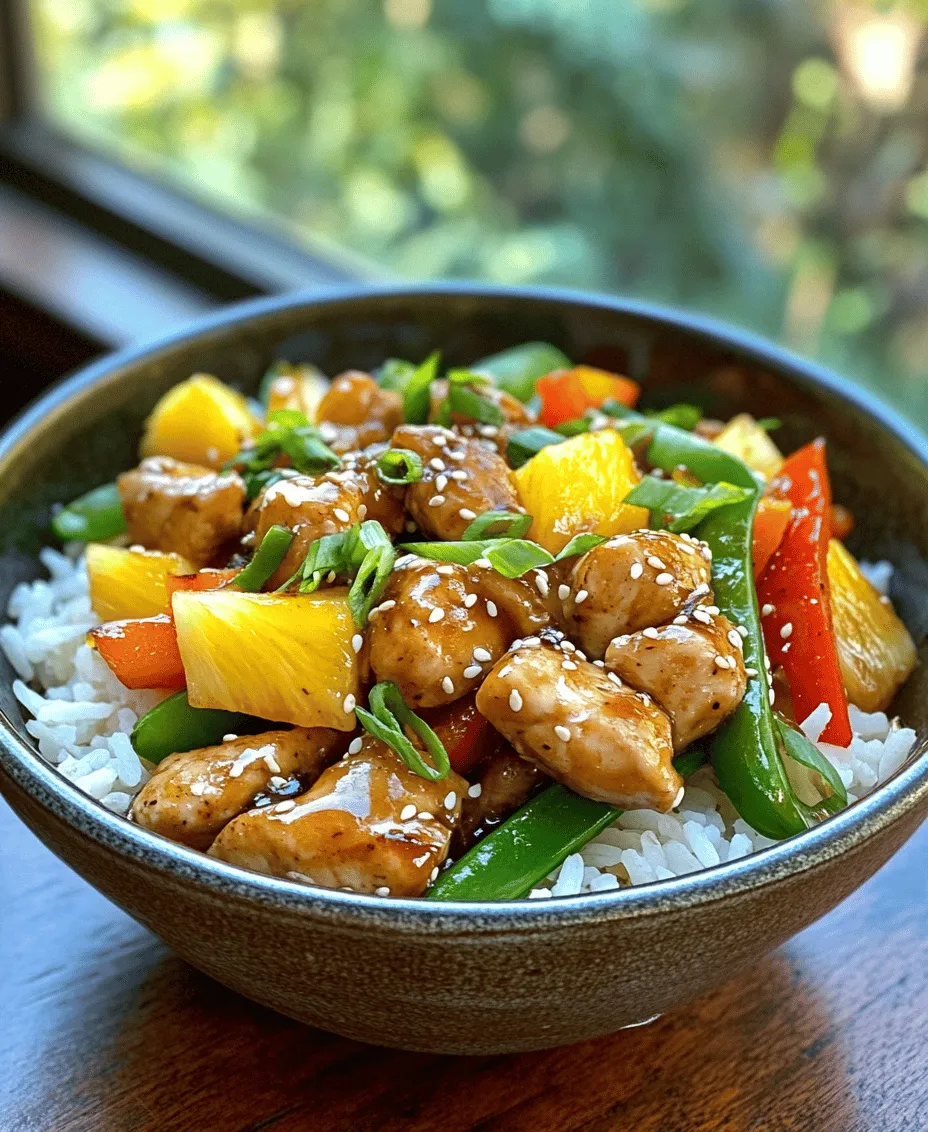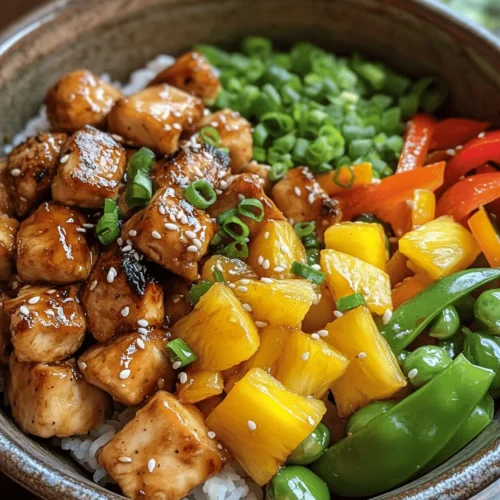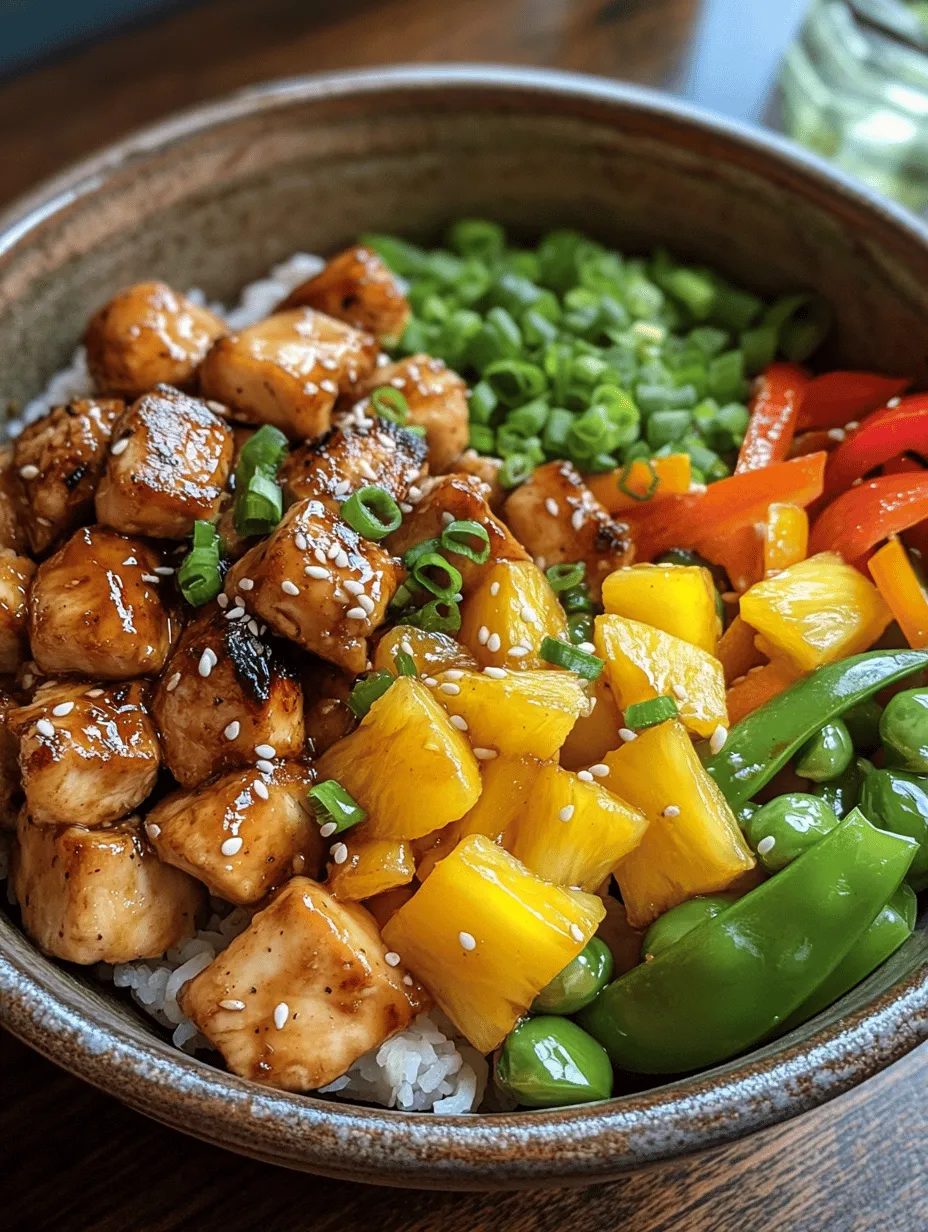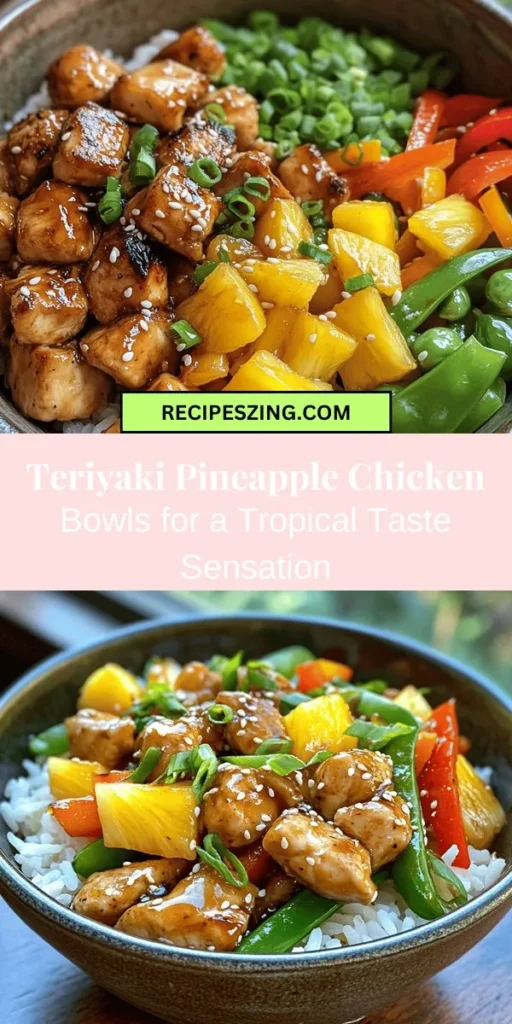Introduction
Teriyaki Pineapple Chicken Bowls are a delightful culinary creation that brings together the sweet and savory flavors of teriyaki sauce, succulent chicken, and the refreshing zing of fresh pineapple. This dish not only tantalizes your taste buds but also provides a vibrant meal option that can easily be made for family dinners or gatherings. With the increasing popularity of Asian-inspired cuisine in Western kitchens, teriyaki has become a household favorite, and this particular recipe exemplifies the perfect blend of tradition and modern flair.
The allure of teriyaki lies in its simplicity and versatility. It offers a rich umami flavor profile that pairs exceptionally well with a variety of ingredients. When combined with the tropical sweetness of pineapple, the result is an irresistible dish that is both appetizing and visually appealing. The use of fresh vegetables adds a crunch and nutritional boost, making this recipe not just a feast for the senses but also a wholesome meal option.
As we delve deeper into this recipe, you will discover the origins of teriyaki cuisine, the health benefits of the ingredients used, and a detailed breakdown of how to prepare this delicious dish. Let’s embark on this culinary journey together!
Understanding Teriyaki Cuisine
Definition and Origin of Teriyaki
The term “teriyaki” derives from the Japanese words “teri,” which means glaze, and “yaki,” meaning to grill or broil. Traditionally, teriyaki cuisine involves marinating meat in a mixture that typically includes soy sauce, sake, mirin, and sugar, then grilling or broiling it to create a glossy finish. This cooking method not only enhances the flavor of the meat but also seals in moisture, resulting in a tender and juicy dish.
Teriyaki has its roots in Japan, where it was originally a cooking technique used for fish and meats. Over the years, it has evolved and gained popularity outside of Japan, particularly in the United States. Today, teriyaki is often associated with grilled chicken, beef, or seafood, served with a side of rice and vegetables, making it a staple in many Asian restaurants and home kitchens alike.
Key Components of Teriyaki Sauce
The signature teriyaki sauce is a harmonious blend of sweet and savory flavors. The key components of a classic teriyaki sauce include:
– Soy Sauce: The base of teriyaki sauce, providing a rich umami flavor.
– Mirin: A sweet rice wine that adds depth and sweetness to the sauce.
– Sake: Japanese rice wine that contributes to the overall flavor profile.
– Sugar: Typically white or brown sugar, which enhances the sweetness and helps create the glaze.
– Ginger and Garlic: Freshly minced or grated, they add aromatic depth to the sauce.
These ingredients work together to create a sauce that can be used to marinate meats, glaze grilled dishes, or serve as a dipping sauce, highlighting its versatility in various culinary applications.
The Popularity of Teriyaki in Modern Cooking
In recent years, teriyaki has surged in popularity, becoming a go-to choice for those seeking quick and easy meals without sacrificing flavor. Its appeal lies in the fact that it can be adapted to suit various diets and preferences. Whether you are a meat lover or a vegetarian, teriyaki sauce can be incorporated into a wide array of dishes, including stir-fries, salads, and, of course, our featured recipe: Teriyaki Pineapple Chicken Bowls.
The fusion of teriyaki with fresh ingredients like pineapple and vegetables not only elevates the dish aesthetically but also enhances its nutritional profile. This adaptability makes teriyaki an excellent option for busy weeknights or special occasions, allowing home cooks to impress their guests with a visually stunning and delectable meal.
Nutritional Benefits of Key Ingredients
Jasmine Rice: A Staple in Asian Cuisine
Jasmine rice is a fragrant long-grain rice that is commonly used in Southeast Asian cooking. Its delicate aroma and slightly sticky texture make it an ideal companion for savory dishes. From a nutritional standpoint, jasmine rice is a good source of carbohydrates, providing energy to fuel your day. It is also low in fat and contains essential vitamins and minerals, making it a wholesome choice for a balanced diet.
When preparing Teriyaki Pineapple Chicken Bowls, jasmine rice serves as the perfect base, absorbing the flavors of the teriyaki sauce and complementing the other ingredients beautifully.
Chicken: A Lean Protein Source
Chicken is a lean protein that is both versatile and nutritious. It is an excellent source of high-quality protein, essential for muscle growth and repair. Additionally, chicken is rich in B vitamins, including niacin and vitamin B6, which play a crucial role in energy metabolism and overall health.
In this recipe, the chicken is marinated in teriyaki sauce, allowing it to absorb all the delightful flavors while remaining juicy and tender. Choosing organic or free-range chicken can further enhance the dish’s nutritional value by ensuring that the meat is free from harmful additives.
Pineapple: A Nutritional Powerhouse
Pineapple is not only a delicious tropical fruit but also a nutritional powerhouse. It is rich in vitamin C, which supports the immune system and promotes skin health. Additionally, pineapple contains bromelain, an enzyme that aids digestion and possesses anti-inflammatory properties.
Incorporating fresh pineapple into the Teriyaki Pineapple Chicken Bowls adds a burst of sweetness and acidity that balances the savory notes of the dish. Its vibrant color and juicy texture make it a standout ingredient, contributing to both the flavor and the visual appeal of the meal.
The Role of Ginger, Garlic, and Vegetables
Ginger and garlic are essential aromatics in many Asian dishes, including teriyaki. Ginger adds a warm, spicy note, while garlic contributes a robust flavor that enhances the overall dish. Both ingredients are known for their health benefits, including anti-inflammatory and antioxidant properties.
Adding colorful vegetables to the Teriyaki Pineapple Chicken Bowls not only boosts the nutritional content but also provides a delightful crunch. Vegetables like bell peppers, broccoli, and snap peas are rich in vitamins, minerals, and fiber, making them excellent additions to any meal.
Ingredients Breakdown
Before we dive into the cooking process, let’s take a closer look at the ingredients that make up this delicious Teriyaki Pineapple Chicken Bowl. Understanding the purpose of each ingredient will help you appreciate the dish even more.
Detailed Examination of Ingredients
– Chicken Breast: The star of the dish, chicken breast is lean and absorbs flavors well. It cooks quickly, making it ideal for stir-frying.
– Fresh Pineapple: Adds sweetness and acidity, balancing the savory flavors of the teriyaki sauce. Fresh pineapple also enhances the dish’s freshness.
– Jasmine Rice: The base of the bowl, jasmine rice provides a fragrant backdrop that complements the main ingredients.
– Teriyaki Sauce: A mixture of soy sauce, mirin, sake, and sugar, this sauce infuses the chicken with rich flavor. You can find store-bought options or make your own for a fresher taste.
– Ginger and Garlic: Essential aromatics that enhance the overall flavor profile of the dish. Freshly grated ginger and minced garlic add a depth of flavor that is hard to replicate.
– Vegetables: Bell peppers, snap peas, and carrots not only add color but also provide crunch and additional nutrients. Choose a variety of vegetables to create a visually appealing dish.
Alternative Ingredients and Tips on Quality
While this recipe calls for specific ingredients, there is room for customization. For instance, you can easily substitute brown rice for jasmine rice if you prefer a whole grain option. Brown rice has a nuttier flavor and provides more fiber, making it a healthy alternative.
When selecting chicken, opt for organic or free-range varieties for the best quality. Fresh pineapple is key to achieving the right balance of sweetness; avoid canned pineapple if possible, as it may contain added sugars and preservatives.
For the vegetables, feel free to experiment with what you have on hand. Broccoli, zucchini, or even bok choy can work beautifully in this dish, adding both flavor and visual appeal.
Step-by-Step Cooking Instructions
Marinating the Chicken
Marinating the chicken is an essential step in preparing Teriyaki Pineapple Chicken Bowls. This process not only infuses the meat with flavor but also helps to tenderize it, resulting in a juicier final dish. Here’s how to do it effectively:
1. Prepare the Marinade: In a mixing bowl, combine equal parts of soy sauce and mirin, along with a tablespoon of sake and a tablespoon of sugar. Add grated ginger and minced garlic to taste. This mixture will serve as the marinade for the chicken.
2. Cut the Chicken: Slice the chicken breast into bite-sized pieces or strips. This increases the surface area for the marinade to penetrate, ensuring that each piece is flavorful.
3. Marinate: Place the chicken pieces in a resealable plastic bag or a shallow dish. Pour the marinade over the chicken, ensuring that all pieces are well-coated. Seal the bag or cover the dish and refrigerate for at least 30 minutes. For optimal flavor, marinating for 2-4 hours is recommended.
4. Drain and Prepare: After marinating, remove the chicken from the fridge and drain the excess marinade. Reserve a small amount of the marinade for later use in the stir-fry.
By following these steps, you will enhance the flavor of the chicken and ensure a delicious outcome in your Teriyaki Pineapple Chicken Bowls. Stay tuned for the next part of this article, where we’ll explore the cooking process and how to assemble this delightful dish!

Cooking the Chicken
To create the perfect Teriyaki Pineapple Chicken Bowls, the chicken must be cooked to perfection. Start by heating a skillet over medium-high heat and adding a tablespoon of oil. Use a high smoke point oil, such as canola or avocado oil, to prevent burning and to achieve that golden brown finish. Proper temperature control is essential here; if the skillet is too hot, the outside may burn before the inside is fully cooked. Conversely, if the skillet is not hot enough, the chicken will stew rather than sear, leading to a less appealing texture.
Once the oil is shimmering, carefully place the marinated chicken in the skillet. Allow it to sear without moving it for about 4-5 minutes to develop a nice crust. After this initial sear, flip the chicken and cook for an additional 4-5 minutes, depending on the thickness of your chicken pieces. The goal is to reach an internal temperature of 165°F (75°C). Using a meat thermometer can help ensure that the chicken is cooked through without overcooking it, which can lead to dryness.
Incorporating Vegetables
While the chicken cooks, it’s time to sauté your vegetables. A mixture of bell peppers, snap peas, and broccoli not only adds color but also provides a crunch that is delightful in contrast to the tender chicken. To retain the crispness and nutrients of your vegetables, sauté them over medium heat for a shorter time. Aim for about 3-4 minutes, stirring frequently. This quick cooking method ensures they remain vibrant and packed with flavor.
For a seasonal twist, feel free to substitute vegetables based on availability. During the summer months, zucchini and corn can provide a sweet, fresh flavor, while in the fall, butternut squash and Brussels sprouts can add a hearty element. The key is to choose vegetables that complement the sweetness of the teriyaki sauce and the tanginess of the pineapple.
Combining Ingredients
Once both the chicken and vegetables are fully cooked, it’s time to bring everything together. Pour the reserved marinade into the skillet. This step is crucial as it not only enhances the flavor but also helps to create a delicious sauce that clings to the chicken and vegetables. Allow the marinade to simmer for about 2-3 minutes to thicken slightly and to ensure that any raw flavors are cooked out.
When adding the pineapple chunks, do so at the last minute. Pineapple cooks quickly, and you want to retain its juiciness and texture. Sauté for just 1-2 minutes, enough to warm the pineapple without turning it mushy. The caramelization of the pineapple will add a delightful sweetness that balances the savory teriyaki flavors.
Assembly of Bowls
With all components ready, it’s time to assemble your Teriyaki Pineapple Chicken Bowls. Start with a base of cooked rice or quinoa. Both options provide texture and a neutral backdrop for your vibrant toppings. Spoon the chicken, vegetables, and pineapple mixture generously over the grains.
To create a visually appealing bowl, consider layering the ingredients rather than just mixing them together. Arrange the chicken in the center, surround it with the sautéed vegetables, and scatter the pineapple artistically. For an added touch, sprinkle sesame seeds and chopped green onions on top. These garnishes not only enhance the visual appeal but also add an extra layer of flavor and crunch.
For those with dietary preferences, this recipe offers excellent customization options. Swap out the chicken for tofu or tempeh for a vegetarian version, or use brown rice or cauliflower rice for a lower-carb alternative.
Serving Suggestions
Pair your Teriyaki Pineapple Chicken Bowls with a refreshing side salad or steamed edamame for a complete meal. For a beverage, a light green tea or a sparkling water infused with lime can cleanse the palate between bites and complement the dish beautifully. If serving at a gathering, consider offering a variety of sauces or condiments such as sriracha or additional teriyaki to cater to different tastes.
Garnishes such as fresh cilantro, lime wedges, or even pickled ginger can elevate the dish. Each of these not only enhances the flavor but also adds a burst of color that makes the bowl look even more inviting.
Cultural Significance of the Dish
Teriyaki Pineapple Chicken Bowls are a fusion dish that embodies the essence of Asian cuisine, particularly Japanese influences, while also integrating tropical flavors from Hawaii. The term “teriyaki” refers to the cooking technique of grilling or broiling meat with a glaze made from soy sauce, sake, and sugar. This method has been adapted globally, with variations emerging to suit local palates.
This dish highlights how culinary traditions can blend and evolve. The incorporation of pineapple reflects a broader trend in Asian cuisine where fruits are used to balance savory dishes. Whether served in a casual family dinner or at a festive gathering, Teriyaki Pineapple Chicken Bowls exemplify the adaptability of flavors, making them a popular choice internationally.
Moreover, the bowl concept itself reflects a growing trend towards healthier eating, where meals are presented in a visually appealing manner while allowing for a variety of ingredients to be included.
Conclusion
Teriyaki Pineapple Chicken Bowls are not only a feast for the eyes but also a deliciously vibrant celebration of flavors that bring joy to any dining occasion. With the balance of sweet, savory, and tangy elements, this dish offers a delightful culinary experience that is both satisfying and nutritious. The flexibility of the recipe allows for endless creativity, making it suitable for novice cooks and seasoned chefs alike.
Encouraging exploration is key—try different vegetable combinations, experiment with grains, or adjust the level of sweetness in the teriyaki sauce to suit your palate. With the health benefits of fresh ingredients and the comforting nature of a warm bowl, Teriyaki Pineapple Chicken Bowls are sure to become a staple in your kitchen. Enjoy the satisfaction of creating this dish that brings both flavor and joy to your table.



